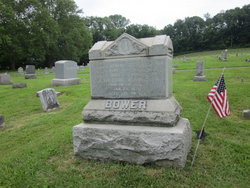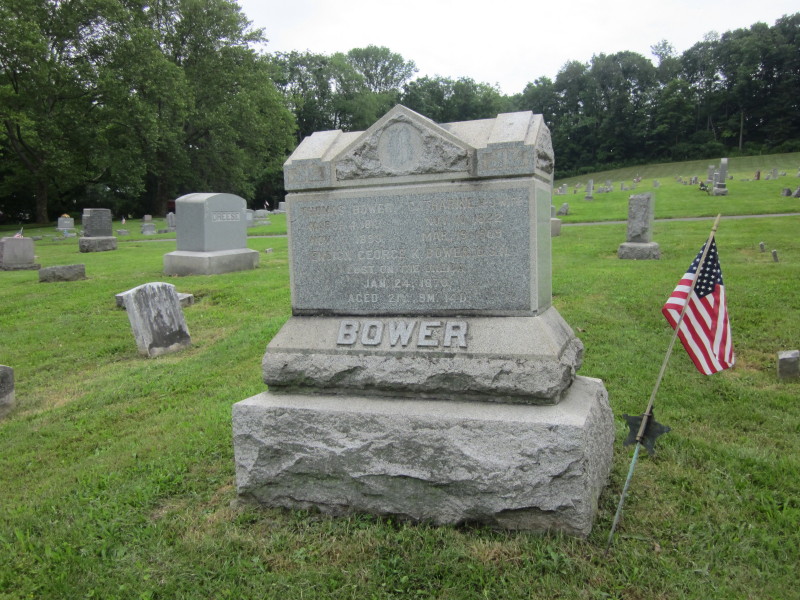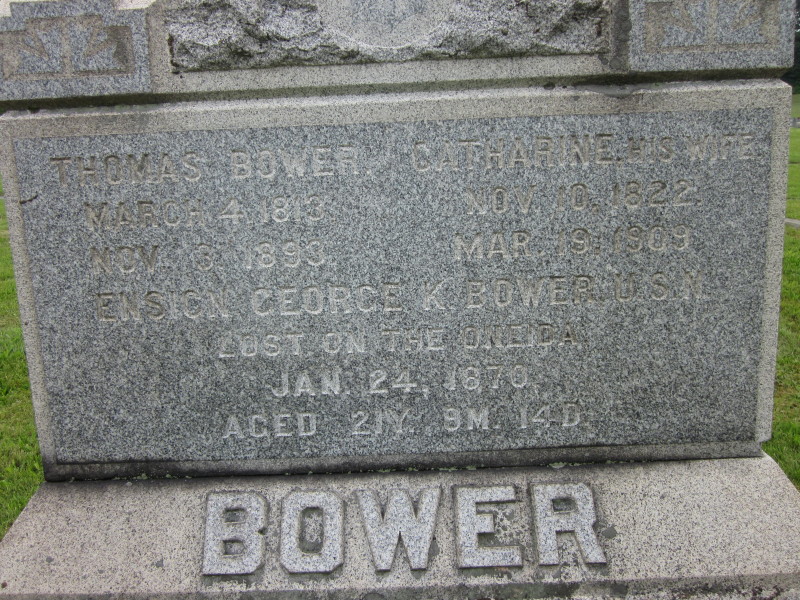Middleburg, March 10, 1870
It becomes our painful duty to announce the unexpected and premature death of Midshipman George Kremer Bower, son of thomas Bower, Esq., of this place. Unfortunately, our friend George was on board the ill-fated "Oneida" which was lost on the Pacific Ocean, some five miles off the coast of Japan, on the 25th of January, last.
The facts of the sad disaster as taken from associate press dispatches are briefly as follows: the United States Corvett "Oneida", left Yokohama on Jan. 23d homeward bound, the steamer which was one of the Asiatic Squadron left her anchorage about 5 o'clock P.M. While the officers were at dinner at 7 P.M., the look-out man shouted "Steamer lights ahead," and a midshipman gave the order "Port helm!" Everything seemed quiet on board the other steamer and this led to he belief that she had not observed the Oneida, although her lights were burning bright.
The Steamer, whic proved to be the "Bombay" of the Peninsular and Oriental line, came right on and struck the Oneida on the starboard, abft the gangway, about half way between the plain and mizzen rigging. A hole was cut, through which the whole interior of the ship was visable. The binnacle wheel and rudder were carried away, and two men standing at the wheel were instantly killed. The Bombay did not stop after crashing through the Oneida, though the guns of the latter, which happened to be loaded, were almost instantly fired to attract her attention and bring her back. Orders were given to lower the boats, but only one life boat was available, the others having been crushed. The life boat was manned by Dr. Saddards, the boatswain, and fifteen of the crew. Five guns were fired, but before the sixth could be discharged the Oneida sunk within ten minutes after she was struck. None of those saved saw a man or heard a voice on board the Bombay. they report that when it became evident that there was no hope of saving the ship the officers gathered around captain Williams. He was heard to say if the ship went down he would go with her. the life boat was obliged to leave the sinking ship to avoid being swamped. After pulling about for awhile, the crew of the life boat seeing none of the crew floating, not one of the 160 who went down, unwillingly put their boat's head landward, about five miles distant. On landing the natives treated them kindly and obtained the assistance of a guide, and they started to walk to Yokohama, which they reached at daylight the next morning. The Bombay was immediaely ordered to the scene of the wreck and succeeded in saving thirty-nine men, who had got into the cutter which floated when the ship went down. Several other vessels, one with Minister Delong on board, proceeded to the scene of the disaster during the day, but no more lives were saved. The Japanese Government sent boats and apparatus to search for the wreck, and if necessary, to buoy the spot.
The passengers on the Bombay were quite surprised when they heard of the calamity, but declare they neither heard any request from the Oneida to stay by them nor minute guns fired. A naval court-martial has been demanded by the captain of the Bombay. The officers and men of the Oneida numbered 176, only 56 of whom, including Dr. Sudders and two junior officers, survived the disaster. Among the officers lost, we notice the name of Midshipman Bower and four of this classmates.
At the recommendation of Hon. William H. Miller, Midshipman Bower entered the United States Naval Academy Sept. 26th 1864 graduated June 16th 1868. He was then ordered to join the Asiatic Squadron under command of Rear Admiral Rowan. In obedience to order sailed from New York Oct. 9th 1868 in the "Alaska" via Aspenwall; thence, to San Francisco in ship Constitution; thence to Yokahama and Shanghai.
Through intrinsic merit George K. Bower had already attained the position of Midshipman and was on his way home for the purpose of promotion to Ensign. At the time of his death he had no quite reached the age of 22.
Midshipman Bower came near losing his life on a previous occasion being stationed on the "Piscataque" subsequently called the "Delaware" the flagship of the squadron, he was transfered to the "Idaho" which set out for the United States on Sep. 20th 1869, and was caught in a typhoon nearly wrecked and compelled to put back to port, under jury masts, upon which occasion he being at the time on duty on deck, came near being swept overboard.
The Nation has lost one of her most talented youths--one whose bravery, talent and high moral character would have placed him high on the role of illustrious men. His self-sacrifice has enshrined and sanctified his memory in the hearts of all who have become familiar with the calamity f the "Oneida."
Called from the quiet walks of a country home, he entered the naval academy flushed with the buoyancy of youth; and the assiduity with which he prosecuted his studies while there were but evidences of the energy, nobility, and patriotic aspirations which characterized him when a comrade and schoolmate in his earlier life.--Amidst the deep sorrow, gloom and mysery which enshroud the death of our friend, we find solace in the dispatches of Minister Delong, who says: "Heroic conduct of the Oneida's" officers--"They refuse to save themselves while a man remains on board, " thus true to the flag under which he served,--tue to his friends--and true to himself, he refused life when purchased at the price of his Soldierly honor, and died with but the moaning sea to sing his requiem,--thus sinking says, fond parents, I have died a worthy son--friend, as have been to you, so have I been to my calling--my country, I have fallen at my post.∼Ensign George K Bower U. S. N.
Lost on the Oneida
aged 21 y 7 m 14 d
---
Date of birth calculated from age at death.
---
The second USS Oneida was a screw sloop-of-war in the United States Navy. During the Civil War, she destroyed the CSS Governor Moore and served in blockade operations. She was attached to the Asiatic Squadron from 1867–1870. She sank in 1870 outside Yokohama, Japan after collision with the British steamer Bombay. The Court of Inquiry found the officers of Oneida were responsible for the collision. Bombay's captain was blamed for not staying at the scene to render assistance - a decision that caused some controversy.[1] Japanese fishing boats saved 61 sailors but 125 men lost their lives. The American government made no attempt to raise the wreck and sold it to a Japanese wrecking company. The company recovered many bones from the wreck and interred them at the their own expense. The Japanese erected a memorial tablet on the grounds of Ikegami Temple in Tokyo and held a Buddhist ceremony in the sailor's memory in May 1889.
(Source: WikiPedia)
Middleburg, March 10, 1870
It becomes our painful duty to announce the unexpected and premature death of Midshipman George Kremer Bower, son of thomas Bower, Esq., of this place. Unfortunately, our friend George was on board the ill-fated "Oneida" which was lost on the Pacific Ocean, some five miles off the coast of Japan, on the 25th of January, last.
The facts of the sad disaster as taken from associate press dispatches are briefly as follows: the United States Corvett "Oneida", left Yokohama on Jan. 23d homeward bound, the steamer which was one of the Asiatic Squadron left her anchorage about 5 o'clock P.M. While the officers were at dinner at 7 P.M., the look-out man shouted "Steamer lights ahead," and a midshipman gave the order "Port helm!" Everything seemed quiet on board the other steamer and this led to he belief that she had not observed the Oneida, although her lights were burning bright.
The Steamer, whic proved to be the "Bombay" of the Peninsular and Oriental line, came right on and struck the Oneida on the starboard, abft the gangway, about half way between the plain and mizzen rigging. A hole was cut, through which the whole interior of the ship was visable. The binnacle wheel and rudder were carried away, and two men standing at the wheel were instantly killed. The Bombay did not stop after crashing through the Oneida, though the guns of the latter, which happened to be loaded, were almost instantly fired to attract her attention and bring her back. Orders were given to lower the boats, but only one life boat was available, the others having been crushed. The life boat was manned by Dr. Saddards, the boatswain, and fifteen of the crew. Five guns were fired, but before the sixth could be discharged the Oneida sunk within ten minutes after she was struck. None of those saved saw a man or heard a voice on board the Bombay. they report that when it became evident that there was no hope of saving the ship the officers gathered around captain Williams. He was heard to say if the ship went down he would go with her. the life boat was obliged to leave the sinking ship to avoid being swamped. After pulling about for awhile, the crew of the life boat seeing none of the crew floating, not one of the 160 who went down, unwillingly put their boat's head landward, about five miles distant. On landing the natives treated them kindly and obtained the assistance of a guide, and they started to walk to Yokohama, which they reached at daylight the next morning. The Bombay was immediaely ordered to the scene of the wreck and succeeded in saving thirty-nine men, who had got into the cutter which floated when the ship went down. Several other vessels, one with Minister Delong on board, proceeded to the scene of the disaster during the day, but no more lives were saved. The Japanese Government sent boats and apparatus to search for the wreck, and if necessary, to buoy the spot.
The passengers on the Bombay were quite surprised when they heard of the calamity, but declare they neither heard any request from the Oneida to stay by them nor minute guns fired. A naval court-martial has been demanded by the captain of the Bombay. The officers and men of the Oneida numbered 176, only 56 of whom, including Dr. Sudders and two junior officers, survived the disaster. Among the officers lost, we notice the name of Midshipman Bower and four of this classmates.
At the recommendation of Hon. William H. Miller, Midshipman Bower entered the United States Naval Academy Sept. 26th 1864 graduated June 16th 1868. He was then ordered to join the Asiatic Squadron under command of Rear Admiral Rowan. In obedience to order sailed from New York Oct. 9th 1868 in the "Alaska" via Aspenwall; thence, to San Francisco in ship Constitution; thence to Yokahama and Shanghai.
Through intrinsic merit George K. Bower had already attained the position of Midshipman and was on his way home for the purpose of promotion to Ensign. At the time of his death he had no quite reached the age of 22.
Midshipman Bower came near losing his life on a previous occasion being stationed on the "Piscataque" subsequently called the "Delaware" the flagship of the squadron, he was transfered to the "Idaho" which set out for the United States on Sep. 20th 1869, and was caught in a typhoon nearly wrecked and compelled to put back to port, under jury masts, upon which occasion he being at the time on duty on deck, came near being swept overboard.
The Nation has lost one of her most talented youths--one whose bravery, talent and high moral character would have placed him high on the role of illustrious men. His self-sacrifice has enshrined and sanctified his memory in the hearts of all who have become familiar with the calamity f the "Oneida."
Called from the quiet walks of a country home, he entered the naval academy flushed with the buoyancy of youth; and the assiduity with which he prosecuted his studies while there were but evidences of the energy, nobility, and patriotic aspirations which characterized him when a comrade and schoolmate in his earlier life.--Amidst the deep sorrow, gloom and mysery which enshroud the death of our friend, we find solace in the dispatches of Minister Delong, who says: "Heroic conduct of the Oneida's" officers--"They refuse to save themselves while a man remains on board, " thus true to the flag under which he served,--tue to his friends--and true to himself, he refused life when purchased at the price of his Soldierly honor, and died with but the moaning sea to sing his requiem,--thus sinking says, fond parents, I have died a worthy son--friend, as have been to you, so have I been to my calling--my country, I have fallen at my post.∼Ensign George K Bower U. S. N.
Lost on the Oneida
aged 21 y 7 m 14 d
---
Date of birth calculated from age at death.
---
The second USS Oneida was a screw sloop-of-war in the United States Navy. During the Civil War, she destroyed the CSS Governor Moore and served in blockade operations. She was attached to the Asiatic Squadron from 1867–1870. She sank in 1870 outside Yokohama, Japan after collision with the British steamer Bombay. The Court of Inquiry found the officers of Oneida were responsible for the collision. Bombay's captain was blamed for not staying at the scene to render assistance - a decision that caused some controversy.[1] Japanese fishing boats saved 61 sailors but 125 men lost their lives. The American government made no attempt to raise the wreck and sold it to a Japanese wrecking company. The company recovered many bones from the wreck and interred them at the their own expense. The Japanese erected a memorial tablet on the grounds of Ikegami Temple in Tokyo and held a Buddhist ceremony in the sailor's memory in May 1889.
(Source: WikiPedia)
Family Members
Advertisement
Explore more
Sponsored by Ancestry
Advertisement









